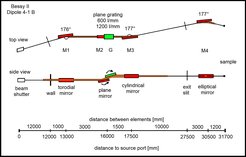BESSY laboratory
Electronic structure group
ISISS, BElChem, and CAT@EMIL facilities

The ultimate surface and element sensitivity on the one hand and the possibility to vary the information depth on the other hand adds an extra quality to XPS when operated with a tuneable X-ray source like a synchrotron. In addition, X-ray absorption spectra (XAS) can be taken at a synchrotron. The HZB (Helmholtz-Zentrum Berlin) and the FHI/MPI-CEC operate three laboratories dedicated to synchrotron based ambient pressure XP spectroscopy at the 3rd generation X-ray source BESSY located in the south east of Berlin. These facilities are: ISISS (Innovative Station for In Situ Spectroscopy, CAT@EMIL (Energy Materials In Situ Laboratory Berlin), and the currently under construction BElChem laboratory (Berlin Joint Lab for ElectroChemical Interfaces). A scheme of the design approach of these facilities is shown as Fig. 1. These laboratories combine in a unique matter a state of the art soft X-ray beamline, a ambient pressure XPS endstation (AP-XPS) (AP-XPS), and a proper, permanent infrastructure on site for experiments with a chemical background.

The beamlines are designed following the principle of a plane grating monochromator (PGM) working in collimated light (Fig. 2). A refocussing optics allows creating small enough X-ray spots with an optimized match to the size of the entrance aperture of the AP-XPS electron spectrometer. This allows a flexible operation adapted to the different needs of the users. For example the monochromator can be operated in different modes i.e. high flux, high spectral resolution, or higher order suppression (thereby increasing the spectral purity of delivered X-ray beam). The beamlines exploit the synchrotron radiation of either a bending magnet (ISISS) or an APPLE II type undulator (CAT@EMIL and BElChem) with the option of variable polarized light.

The beamlines offer a high photon flux up to 1*1012 photons/ sec/ 0.1A ring current and a broad energy range 90eV - 2000eV with a high photon flux. The monochromatic photon flux of the ISISS, CAT@EMIL and BElChem beamlines is compared in Fig. 3 for exit slit settings that result in a similar spectral resolution of all three beamlines. The available energy range at CAT is extended to the tender X-ray range of 2keV – 10keV by exploiting the radiation of an additionally installed cryogenic in-vacuum undulator (U17) and implementing a nitrogen cooled double crystal monochromator (DCM) in the beamline. Hence, EMIL represents an unique beamline at BESSY II and very hard to find even at other synchrotron sources in the world that covers a very wide and continuous photon energy range from the soft energy region up to the tender X-ray region combined in one focus. The MPG operates a high kinetic energy AP-XPS spectrometer inside the CAT lab. This spectrometer is capable to cover a kinetic energy range of photoelectrons up to 7000eV nicely matching the available photon energy range for excitation at the CAT beamline.
The photon beam is re-focused after the exit slit to ensure a high brilliant X-ray spot at the sample position. The spot size is typically 150µm x 80µm (h x v). More information about the high pressure XPS apparatus can be found here. The AP-XPS spectrometers are operated inside dedicated laboratories. Fig. 4a and 4b show the ISISS lab. The installation of an elaborated ventilation and safety system makes it feasible to use hazardous substances (e.g. flammable, explosive, or poisonous) as feed gas. At ISISS you can find a preparation lab on site, too (Fig. 4c). This allows basic sample pre-treatments like washing, drying and pelletising.


While the ISISS and BElChem facilities are located inside the BESSY experiment hall, the CAT laboratory is part of a newly constructed laboratory and office building outside of but directly connected to the experiment hall of BESSY (Fig. 5). CAT offers about 150m2 of lab space and a sophisticated infrastructure that is required for in situ experiments with a chemical background like for instance gas supply and management, lab and local ventilation systems, exhaust lines, gas sensors, safety cabinets, and a glove box for air sensitive materials.

The BElChem beamline is currently under in-house-research operation but not inside a hutch, yet. It is planned to establish a dedicated BElChem laboratory similar to ISISS and CAT@EMIL during the summer shut-down at BESSY in 2022. The optical layout of the existing beamline will be upgraded to give an even better match to the planned scientific projects. A sketch of the planned lab can be found as Fig. 6. An additional tender X-ray beamline will be constructed within the framework of the BElChem project by HZB/MPG.
The CAT@EMIL beamline has started friendly user operation at the end of 2019. As example, some results are presented as Fig. 7.







